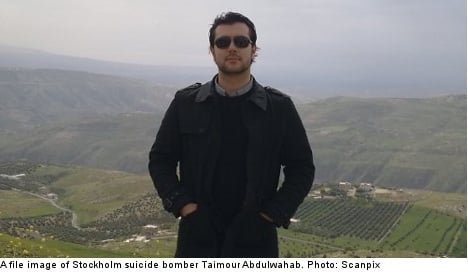The 28-year-old Abdulwahab blew himself up on December 11th, 2010 in central Stockholm. He was killed after one of the many charges he was carrying exploded after he made several unsuccessful attempts to detonate the explosives.
In a Wednesday press conference, investigators attempted to provide details about the hours leading up to the attack.
“This is an attack that we think was meant to be of much greater scope than what it turned out to be,” prosecutor Agnetha Hilding Qvarnström told reporters, according to the Dagens Nyheter (DN) newspaper.
According to investigators, Abdulwahab was alone from the time he left his home in Tranås in central Sweden until he ended up dead on a Stockholm street several hours later.
The car he drove to Stockholm was also set alight in conjunction with the attack.
In the vehicles charred remains, investigators found an unexploded bomb fashioned from a pressure cooker. A similar type of bomb was found on Abdulwahab’s body, but never exploded. A walkie-talkie was also recovered from the burned out car.
Swedish security service Säpo said that Abdulwahab likely meant to start a fire and then detonate a bomb with the walkie-talkie.
“Something also went wrong in this case,” Säpo deputy head Anders Thornberg told reporters, according to the TT news agency.
Based on the investigation’s findings thus far, there is nothing to indicate that Abdulwahab had any accomplices present at the site of the attack.
“Nothing points to anything else. We are still working on the question of whether or not he received financial or economic support,” said Säpo head Anders Danielsson.
Hilding Qvarnström emphasized that a lot of work remains in the probe and that much is dependent on cooperation with other countries.
Surveillance footage shows how Abdulwahab walked from his car along Drottninggatan, a busy pedestrian thoroughfare filled at the time with holiday shoppers.
He can be seen walking back toward the car, which was parked on the adjacent Bryggargatan, to check on the bomb which refused to explode.
“The bombs themselves weren’t all that complex,” said Hilding Qvarnström.
During the press conference, investigators showed films of test explosions of bombs similar to the one made by Abdulwahab, demonstrating how powerful it could have been if fully detonated.
“What we can say is that there were a lot of people on Drottninggatan at the time. We can only imagine what could have happened; how many could have been killed,” said Hilding Qvarnström.
Abdulwahab was carrying approximately four kilogrammes of explosives in a pressure cooker attached to his midsection.
He was also carrying a backpack which contained another pressure cooker and nine additional kilogrammes of explosives.
In the attack, only a portion of the explosives Abdulwahab carried on his stomach exploded.
According to investigators, Abdulwahab had the bomb fastened to his stomach when he left Tranås. Surveillance footage from a petrol station showed something protruding from underneath his clothes.
On the approach to Drottinggatan, Abdulwahab may have taken a wrong turn because faulty coordinates had been entered in his GPS, causing him to arrive later than planned.
Danielsson said that there is no solid evidence indicating that Abdulwahab was a member of al-Qaeda.
A Scottish probe into an alleged accomplice, Nasserdine Menni, indicates that some terror network may have been behind the attack.
According to Scottish investigators, Menni and Abdulwahab knew each other since 2003 and had been planning their actions for years.
Menni assumed false identities, misled immigration authorities and banks, and opened several accounts starting in 2005.
Up until 2010, he directed at least 60,000 kronor ($9,000) to Abdulwahab. Another person received around 10,000 from Menni.
In the summer of 2009, Abdulwahab traveled to Syria and Iraq for terrorist training.
He had originally come to Sweden in the early 1990s before moving to the UK in 2001 to study in Luton, which is where he met Menni.
Three weeks prior to the Stockholm suicide bombing, Abdulwahab returned to Sweden, bought a car and bomb-making supplies.
He placed a telephone call to Iraq and received a call from Iraq on the day of the attack, when he also tried to call Menni.



 Please whitelist us to continue reading.
Please whitelist us to continue reading.
Member comments